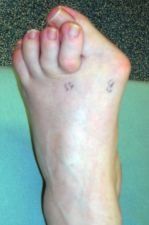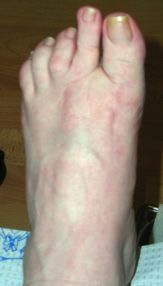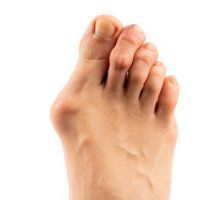Bunions
What is a Bunion?
Bunions
are often described as a bump on the side of the big toe. A bunion is much more than that, though. The visible bump reflects changes in the bony framework of the front part of the foot. With a bunion, the big toe leans toward the second toe, rather than pointing straight ahead. This throws the bones out of alignment producing the bunion's "bump." Bunions are a progressive disorder. They begin with a leaning of the big toe, gradually changing the angle of the bones over the years and slowly producing the characteristic bump, which continues to become increasingly prominent. Usually, the symptoms of bunions appear at later stages, although some people never have symptoms.
What Causes A Bunion?
Bunions are most often caused by an inherited faulty mechanical structure of the foot. It is not the bunion itself that is inherited, but certain foot types that make a person prone to developing a bunion. Although wearing shoes that crowd the toes won't cause bunions in the first place, it can make the deformity progressively worse and more painful.
Symptoms
Symptoms occur most often when wearing shoes that crowd the toes, shoes with a tight toe box, or high heels. Because of this, women are more likely to have symptoms than men. Also, spending long periods on your feet can aggravate the symptoms of bunions. Symptoms which occur at the site of the bunion may include:
- Pain or soreness
- Inflammation and redness
- A burning sensation
- Perhaps some numbness
Other conditions that may appear with bunions include calluses on the big toe, sores between the toes, ingrown toenail, and restricted motion of the toe.
Diagnosis
Bunions are readily apparent - you can see the prominence at the base of the big toe or side of the foot. However, to fully evaluate your condition, Dr. Sheff may take x-rays to determine the degree of the deformity and assess the changes that have occurred. Because bunions are progressive, they don't go away, and will usually get worse over time. But not all cases are alike - some bunions progress more rapidly than others. Once Dr. Sheff has evaluated your particular situation, a treatment plan can be developed that is suited to your needs.
Treatment
Sometimes observation of the bunion is all that's needed. Periodic office evaluation and x-ray examination can determine if your bunion deformity is advancing, thereby reducing your chance of irreversible damage to the joint. In many other cases, however, some type of treatment is needed.
Early treatments are aimed at easing the pain of bunions, but they won't reverse the deformity itself. These options include:
Early treatments are aimed at easing the pain of bunions, but they won't reverse the deformity itself. These options include:
- Changes in shoewear. Wearing the right kind of shoes is very important. Choose shoes that have a wide toe box and forgo those with pointed toes or high heels, which may aggravate the condition.
- Padding. Pads placed over the area of the bunion can help minimize pain. You can get bunion pads at most drug stores.
- Activity modifications. Avoid activity that causes bunion pain, including standing for long periods.
- Medications. Nonsteroidal anti-inflammatory drugs (NSAIDs), such as ibuprofen, may help to relieve pain.
- Icing. Applying an ice pack several times a day helps reduce inflammation and pain.
- Injection therapy. Although rarely used in bunion treatment, injections of corticosteroids may be useful in treating the inflamed bursa (fluid-filled sac located in a joint) sometimes seen with bunions.
- Orthotic devices. Custom orthotic devices (rigid inserts worn in your shoes) can be fabricated for you that can help relieve some of the pain you are experiencing at your big toe. Furthermore, these orthotics can help slow down the progressive nature of this deformity.
When Is Bunion Surgery Needed?
When the pain of a bunion interferes with daily activities, it's time to discuss surgical options. Together you can decide if surgery is best for you. Recent advances in surgical techniques have led to a very high success rate in treating bunions. A variety of surgical procedures are performed to treat bunions. The procedures are designed to remove the "bump" of bone, correct the changes in the bony structure of the foot, as well as correct soft tissue changes that may also have occurred. The goal of these corrections is the elimination of pain. In selecting the procedure or combination of procedures for your particular case, Dr. Sheff will take into consideration the extent of your deformity based on the x-ray findings, your age, your activity level, and other factors. The length of the recovery period will vary, depending on the procedure or procedures performed.
All surgeries are performed on an out-patient basis at Newport Hospital. The bunionectomy procedure is one of the most common operations performed by Dr. Sheff. Recovery depends specifically on what type of bunion operation is best for you and may involve the use of crutches but more commonly only requires the use of a surgical shoe and limited activities for the first two to four weeks. However, every patient is an individual and will heal at different rates.
Various types of anesthesia are available to the patient, including general anesthesia, spinal anesthesia, iv sedation, or local anesthesia. Most bunion operations can be done with a combination of local anesthesia and IV sedation. This is the same anesthesia that one receives for a colonoscopy. It is also referred to as "twilight anesthesia," for the patient falls asleep once the medication is introduced and wakes up after the procedure without the untoward effects often associated with general anesthesia (nausea, grogginess, etc.).
Don't live with the pain of a bunion. Contact Newport Family Foot Care
today at 401-846-8050
to schedule a consultation.
Every fight is a food fight when you're a cannibal.
- Demetri Martin








